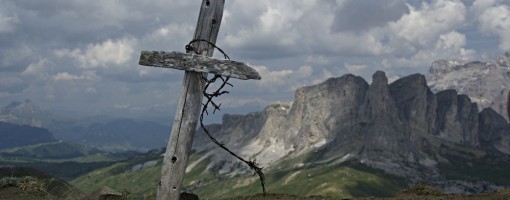
Climbs 2
Rocktype Limestone
Altitude 2452m a.s.l
Faces all
War memorial on Col di Lana, Dolomites © Daniel Wildey
Crag features
This area has a good Via Ferrata/Mountaineering route though some spectacular WW1 history. During World War I the mountain, alongside the neighbouring Monte Sief, was the scene of heavy fighting between Austria and Italy. It is now a memorial to the War in the Dolomites.
During the years of 1915/16, Italian troops from the 12th Infantry and the 14th Alpine Companies repeatedly attempted to storm the peak, defended first by the German Alpenkorps and later by Austrian regiments. These attempts resulted in heavy losses; 278 Italians died due to avalanches alone. However this is not the only reason that the Italians dubbed it 'Col di Sangue', 'Blood Mountain'. Like all sides in the First World War, the Italian Army sought to conquer the summit with relatively large forces, paying a high price in casualties.
Lieutenant Caetani of the Italian engineers developed a plan for mining the peak, which was executed silently using hand-operating drilling machines and chisels. At the start of 1916, the Austrians learned through an artillery observer on Pordoi Pass that the summit had been mined. The Austrians began a counter mine, and exploded this on 5 April 1916. The counter mine was, however, too far away from the Italian explosive tunnel. This was laid with five tonnes of blasting gelatin. On the night of 16/17 April 1916, the 5th Company of the 2nd Tyrolean Kaiserjäger regiment was relieved by the 6th Company, under Oberleutnant Anton von Tschurtschenthaler. The struggle reached its zenith on the night of 17/18 April 1916, when at around 23:30 the summit was blasted. The Austrians under Tschurtschenthaler then had to surrender the mountain; however they were able to maintain a position on Monte Sief, which is linked to Col di Lana by a ridge, thereby obstructing the Italian breakthrough in the area.
In 1932, the architect Kuno Krissler (from Bolzano-Bozen) planned a memorial that would have restored the contour of the summit, but it was never constructed. Today a chapel stands on the summit as a memorial to the soldiers that fell in battle. The remains of a barracks and decaying gun and communications trenches have been left behind from the war. There is also a small war museum on the mountain.
Approach notes
There are several possible approaches to the summit that can be found by using a map. The longer outing from 'Pieve' offers an opportunity to visit a small museum with an interesting display of wartime memorabilia and photos.
| There are no comments from visitors to this crag. |
Climbs at this crag
| Name | Grade | Stars | Type | Logs | Partner Ascents |
|---|
These climbs you have climbed by seconding or top-roping.
These climbs you have Dogged.
These climbs you Did not Finish.
Climbs are waiting to be checked by a crag moderator, and may not be accurate. Climbs can't be verified by a crag moderator, and they need more information to confirm it. Climbs are no longer climbable.
Moderators Updates to this page are checked by a UKC volunteer ERU